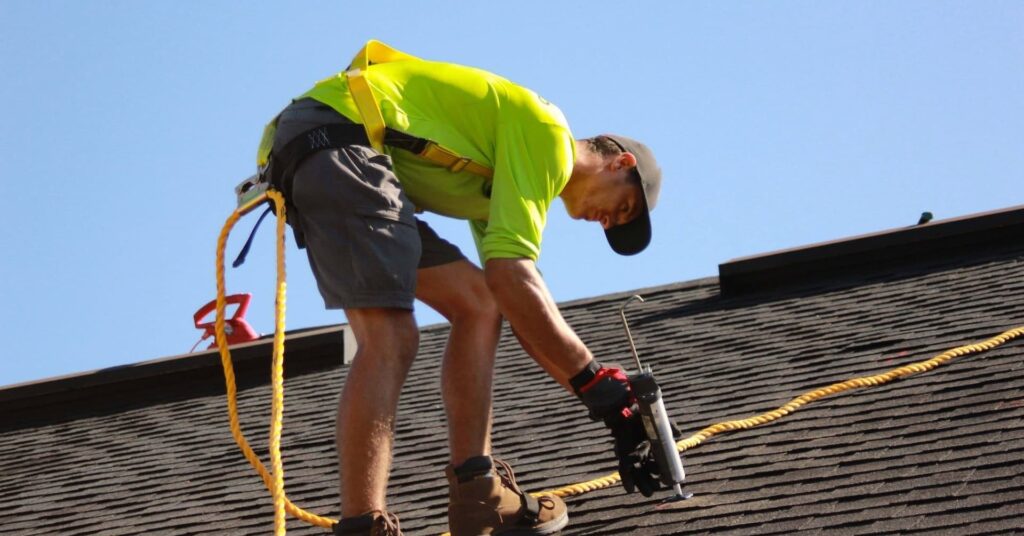Roofing
How to Shingle a Hip Roof: A Step-by-Step Installation Guide
How to Shingle a Hip Roof? In the realm of roofing, hip roofs stand as architectural marvels, known for their elegant slopes and visual appeal.
Shingling a hip roof is not just a construction task; it’s an art form that demands precision, expertise, and a keen eye for detail.
Understanding the complexities of this process is paramount, ensuring not only the roof’s aesthetic finesse but also its resilience against the forces of nature.
At its core, a hip roof features four sloping sides, meeting at a common ridge, forming a gentle pyramid-like shape.
This unique design not only adds charm to a structure but also provides excellent stability, especially in areas prone to high winds or heavy snowfall.
However, shingling a hip roof requires a specialized approach. Each slope and angle demands careful consideration, making it a challenge that only skilled craftsmen can truly appreciate.
In this exploration, we embark on a journey to unravel the art of shingling a hip roof. We delve deep into the techniques, tools, and materials that transform a bare roof into a resilient shield, protecting homes and establishments from the vagaries of weather.
From the careful selection of asphalt shingles to the strategic placement of roofing nails, every step in this process contributes to the roof’s integrity and longevity.
Join us as we navigate the intricacies of this craft. Whether you’re a homeowner seeking insights into the roofing process or a budding roofer eager to master the art.
This journey will equip you with knowledge, tips, and techniques essential for shingling a hip roof with finesse.
Embrace the challenge and discover the gratification that comes with transforming a simple roof into a work of architectural elegance and structural strength.
Tools for Shingling a Hip Roof:
- Asphalt Shingles:
- Use: Provide weather protection and enhance the roof’s visual appeal.
-
Underlayment:
- Use: Act as a moisture barrier between shingles and roof deck, preventing water infiltration.
-
Roofing Nails:
- Use: Secure shingles to the roof deck, ensuring they are firmly attached.
-
Roofing Hammer:
- Use: Specialized hammer with a flat head for driving roofing nails accurately, essential for precise shingle installation.
-
Utility Knife:
- Use: Cut shingles to fit around angles, vents, or edges, ensuring a proper fit and neat appearance.
-
Roofing Nailer:
- Use: A pneumatic tool that speeds up the nailing process, ensuring quick and efficient shingle installation.
-
Chalk Line:
- Use: Create straight and uniform chalk lines to guide the placement of shingles, ensuring proper alignment.
-
Ladder:
- Use: Provide access to the roof, ensuring a stable and safe platform for working at heights.
-
Safety Gear:
- Use: Includes harness, gloves, and non-slip shoes for personal protection, ensuring safety throughout the roofing process.
Materials for Shingling a Hip Roof:
-
Asphalt Shingles:
- Use: Provide weather protection, enhance the roof’s appearance, and offer durability against various weather conditions.
-
Underlayment:
- Use: Acts as a moisture barrier between shingles and roof deck, preventing water infiltration and enhancing the roof’s longevity.
-
Roofing Nails:
- Use: Secure shingles to the roof deck, ensuring they are firmly attached and resistant to wind uplift.
-
Roofing Cement:
- Use: Applied beneath cut shingles, vents, or other roofing elements to provide additional adhesion and prevent water infiltration.
-
Roofing Staples:
- Use: Secure underlayment and other roofing materials to the roof deck, ensuring a secure and watertight installation.
-
Flashing:
- Use: Metal strips installed at vulnerable areas (such as valleys and chimneys) to prevent water penetration and direct water away from these critical points.
Understanding the specific tools and materials, along with their respective uses, is essential for a successful hip roof shingling project.
Proper utilization of these items ensures a durable, weather-resistant, and visually appealing roof structure.
1st Step: Preparation and Safety Measures
Before you start, inspect the roof for any existing damage. Clean debris, repair any leaks, and ensure the roof deck is in good condition.
Use safety harnesses, secure ladders, and wear appropriate safety gear throughout the process.
2nd Step: Install Underlayment
Begin by covering the roof deck with underlayment. Start at the bottom edge of the roof and roll out the underlayment horizontally, securing it with staples. Overlap each row to prevent water infiltration.
3rd Step: Layout and Snap Chalk Lines
Create horizontal chalk lines to guide the placement of the first row of shingles. Measure and mark equal distances on both ends of the roof and snap chalk lines to maintain straight alignment.
4th Step: Shingle the Bottom Edge
Start at the bottom edge of the roof. Place the first row of shingles with the bottom edge overhanging the drip edge. Secure them using roofing nails, placing nails near the tar strip and ensuring proper alignment.
5th Step: Stagger Shingles
For the subsequent rows, stagger the shingles to prevent water from seeping through the gaps. Follow a consistent pattern, usually half or one-third shingle length, for each new row.
6th Step: Cut and Fit Shingles
Use a utility knife to cut shingles to fit around angles, vents, or edges. Ensure a snug fit, leaving room for expansion due to temperature changes. Apply roofing cement beneath cut shingles for added adhesion.
7th Step: Install Ridge Vents
Once the main area is shingled, install ridge vents along the hip of the roof. Cut shingles to fit around the vents, ensuring they are properly sealed and secured with roofing nails.
8th Step: Final Inspections and Cleanup
Inspect the entire roof to ensure all shingles are securely attached and properly aligned. Check for any exposed nails and cover them with roofing cement.
Clean up debris and ensure the roof and surrounding area are clear.
By following these steps and utilizing the right tools, you can shingle a hip roof effectively.
Remember, if you are unsure about any part of the process, it’s always best to consult with a professional roofing contractor to ensure the job is done correctly and your roof remains secure for years to come.
Types of shingles
There are many different types of shingles available, each with its own advantages and disadvantages. The most common types of shingles are:
1. Asphalt shingles:
Asphalt shingles are the most popular type of shingle, and for good reason. They are relatively inexpensive, easy to install, and durable. They are also available in a wide variety of colors and styles.
2. Metal shingles:
Metal shingles are more expensive than asphalt shingles, but they are also more durable. They are also fire-resistant and can withstand high winds. Metal shingles are available in a variety of colors and finishes.
3. Slate shingles:
Slate shingles are the most expensive type of shingle, but they are also the most durable. They are also fire-resistant and can withstand high winds. Slate shingles are available in a variety of colors and finishes.
Choosing the right shingles
When choosing shingles for your hip roof, there are a number of factors to consider, such as:
Climate:
The climate you live in will play a role in determining the best type of shingle for your roof. For example, if you live in an area with severe weather conditions, you may want to choose metal shingles or slate shingles.
Slope of your roof:
The slope of your roof will also play a role in determining the best type of shingle for your roof. For example, if your roof has a steep slope, you may want to choose shingles that are specifically designed for steep slopes.
Budget:
Shingles can range in price from a few dollars per square foot to over a hundred dollars per square foot. It is important to set a budget before you start shopping for shingles.
Installing shingles in different weather conditions
Shingling a roof can be done in all weather conditions, but there are some things to keep in mind if you are shingling in cold weather or wet weather.
Cold weather:
If you are shingling in cold weather, it is important to use shingles that are specifically designed for cold weather conditions. Cold weather shingles are more flexible and easier to work with in cold temperatures.
Wet weather:
If you are shingling in wet weather, it is important to take precautions to prevent the shingles from getting wet. You can do this by covering the shingles with a tarp or by using shingles that are specifically designed for wet weather conditions.
Troubleshooting common problems
There are a few common problems that can occur when shingling a hip roof:
Shingles blowing off: Shingles can blow off the roof in high winds. To prevent this, it is important to nail the shingles down securely. You may also want to use a roofing adhesive to help keep the shingles in place.
Leaks: Leaks can occur around vents, chimneys, and other penetrations in the roof. To prevent leaks, it is important to install flashing around all penetrations in the roof.
Ice dams: Ice dams can form on the roof in cold weather. Ice dams can cause water to back up behind the shingles and leak into the roof. To prevent ice dams, it is important to make sure that your roof is properly insulated and ventilated.
Installing shingles around vents and chimneys
To install shingles around vents and chimneys, you will need to cut the shingles to fit around the vents and chimneys. You can use a utility knife and a straight edge to cut the shingles.
Once you have cut the shingles to fit, you can nail them down securely.
Repairing damaged shingles
If a shingle is damaged, you can simply replace it with a new one. To replace a damaged shingle, simply remove the old shingle and nail the new shingle in place.
Maintenance and upkeep of a shingled hip roof
To maintain your shingled hip roof, it is important to inspect the roof regularly for damage. If you find any damaged shingles, you should replace them immediately.
You should also clean the roof regularly to remove dirt and debris.
By following these tips, you can keep your shingled hip roof in good condition for many years to come.
Conclusion
Shingling a hip roof is a challenging task, but it is possible to do it yourself with the right tools and materials. By following the steps in this article, you can shingle your hip roof and protect your home from the elements for years to come.
Here are a few key points to remember when shingling a hip roof:
- Choose the right shingles for your climate, roof slope, and budget.
- Be sure to install flashing around vents, chimneys, and other penetrations in the roof.
- Nail the shingles down securely to prevent them from blowing off in high winds.
- Inspect the roof regularly for damage and replace damaged shingles immediately.
- Clean the roof regularly to remove dirt and debris.
If you are not comfortable shingling your hip roof yourself, you can hire a professional roofer to do the job for you.
Frequently Asked Questions(FAQ’s)
1. How do you cut shingles for a hip roof?
When shingling a hip roof, the shingles along the hip need to be cut at an angle to match the slope of the roof.
You can achieve this by measuring the angle of the hip and using a utility knife or roofing scissors to cut the shingles accordingly. Precise measurements and careful cutting are essential to ensure a proper fit.
2. Do you overlap shingles at the hip?
Yes, shingles at the hip of a roof should be overlapped. Overlapping helps to prevent water from seeping under the shingles and provides a better seal.
Follow the manufacturer’s instructions for the specific type of shingles you are using, as the overlap requirements can vary.
3. How much shingle waste on a hip roof?
The amount of shingle waste on a hip roof can vary based on the complexity of the roof, the pitch of the roof, and the accuracy of your measurements and cuts.
It’s a good practice to purchase a bit more shingles than the calculated area to account for mistakes, intricate cuts, and waste.
Typically, a waste allowance of around 10% is recommended, but it’s best to consult with a roofing professional for an accurate estimate.
4. How do you find the square footage of a hip roof?
To find the square footage of a hip roof, you can break the roof down into sections (triangles and trapezoids), calculate the area of each section, and then add them together.
Alternatively, you can use specialized roofing calculators or software to simplify the process. The formula for the area of a trapezoid (a common shape in hip roofs) is (a+b)×ℎ2, where and are the lengths of the parallel sides, and ℎ is the height (or width) of the trapezoid.
5. Shingling a pyramid hip roof:
Shingling a pyramid hip roof follows similar principles as shingling a regular hip roof. Each side of the pyramid will have shingles cut at angles to match the slopes, and they should be overlapped properly to ensure a watertight seal.
6. How to shingle a hip and valley roof:
Shingling a hip and valley roof involves careful measuring and cutting to fit the shingles around the intersecting hips and valleys.
Special attention is needed at these points to maintain the integrity of the roof and prevent leaks. Proper flashing installation at valleys is also crucial.
7. Do you overlap shingles on a hip roof?
Yes, as mentioned earlier, shingles on a hip roof should be overlapped to create a weatherproof barrier. Overlapping the shingles prevents water infiltration and enhances the roof’s durability.
8. Hip and ridge shingles installation:
Hip and ridge shingles are specially designed for the ridges and hips of a roof. They are flexible and can be moulded over the contours of the roof.
To install them, follow the manufacturer’s guidelines, which often include using nails or adhesive to secure them in place.
Proper installation ensures they provide an effective seal and enhance the roof’s appearance.
9. How to install hip cap shingles:
Hip cap shingles are installed at the ridge of a hip roof. They should be nailed down according to the manufacturer’s instructions, with attention to proper alignment and overlap.
Proper installation of hip cap shingles is essential to prevent wind-driven rain and debris from getting under the shingles and causing damage.
Remember, when it comes to roofing projects, it’s crucial to follow local building codes and manufacturer’s instructions to ensure a safe and effective installation.
If you’re not experienced with roofing projects, it’s advisable to consult or hire a professional roofer.
Recent Posts
- How Long Does A Thatched Roof Last: The Ultimate Guide
- Tile Roof Repair: Tips and Techniques. The Ultimate Guide
- What is tpo roofing? A Comprehensive Guide
- How long does a metal roof last? Exploring the Lifespan of Metal Roofs



